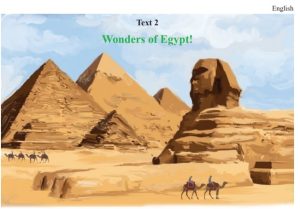Opinion Matters; 1.2.1
Opinion Matters:
Text: 1

As Bangalees Bangabandhu’s speech at the United Nations Assembly is a matter of great pride for us. On September 25th 1974, Bangabandhu delivered his historic speech during the 29th session of the United Nations General Assembly, just a week after, Bangladesh became a member of the UN. The president of the UN welcomed Bangabandhu Sheikh Mujibur Rahman to address the General Assembly. He started his speech by saying, “Today as I stand before this Assembly, I share with you
profound satisfaction that the 75 million people of Bangladesh are now represented in this Parliament of Man…” This speech is remarkable in the history of Bangladesh for primarily two reasons. Firstly, it marked the first time a speech was delivered in Bangla at the UN. Secondly, it introduced fresh ideas and policies aimed at building a brave new world, free of economic inequalities, social injustice, military aggression and threats of nuclear war.
বাঙালি হিসেবে জাতিসংঘের অধিবেশনে বঙ্গবন্ধুর ভাষণ একটি বিষয় আমাদের জন্য অত্যন্ত গর্বের। ১৯৭৪ সালের ২৫শে সেপ্টেম্বর বঙ্গবন্ধু তার ঐতিহাসিক ভাষণ দেন মাত্র এক সপ্তাহে জাতিসংঘের সাধারণ পরিষদের ২৯তম অধিবেশনে ভাষণ এরপর বাংলাদেশ জাতিসংঘের সদস্যপদ লাভ করে। স্বাগত জানান জাতিসংঘের প্রেসিডেন্ট ড সাধারণ পরিষদে ভাষণ দেবেন বঙ্গবন্ধু শেখ মুজিবুর রহমান। সে শুরু করেছিল তাঁর বক্তৃতা এই বলে, “আজ আমি এই বিধানসভার সামনে দাঁড়িয়ে আপনাদের সাথে শেয়ার করছি গভীর সন্তুষ্টি যে বাংলাদেশের ৭৫ মিলিয়ন মানুষ এখন প্রতিনিধিত্ব করছে মানুষের এই সংসদে…” এই ভাষণ বাংলাদেশের ইতিহাসে অসাধারণপ্রাথমিকভাবে দুটি কারণে। প্রথমত, এটি প্রথমবারের মতো একটি বক্তৃতা দেওয়া হয়েছিল জাতিসংঘে বাংলা। দ্বিতীয়ত, এটি একটি নতুন ধারণা এবং নীতির সূচনা করেছে যার লক্ষ্য ছিল একটি
সাহসী নতুন বিশ্ব, অর্থনৈতিক বৈষম্য, সামাজিক অবিচার, সামরিক আগ্রাসন এবং মুক্ত পারমাণবিক যুদ্ধের হুমকি।
Fact
Text-1
It was 25th September 1974, Bangabandhu gave his historic speech in the 29th session of the United
Nations General Assembly just after a week Bangladesh became a member of the UN.
Writers’ opinions regarding the text
As Bangalees, Bangabandhu’s speech at the United Nations Assembly is a matter of great
pride for us.
How writers’ opinions influenced me to develop my opinion about the text
Here, the writer’s opinions make my understanding that the speech is extremely important in
the history of Bangladesh. Most importantly, the writer’s opinions regarding the speech help me to understand the positive tone of the text.
Test:2

How the Pyramids at Giza were built is one of Egypt’s biggest mysteries. These monumental tombs are relics of Egypt’s Old Kingdom era and were constructed approximately 4,500 years ago. The Pyramids were constructed throughout Ancient Egyptian history as a means for Pharaohs to display their power. It was believed that a Pharaoh was a semi-divine being who ruled on Earth during life and then transitioned into an afterlife amongst the gods.
গিজার পিরামিডগুলি কীভাবে তৈরি হয়েছিল তা মিশরের সবচেয়ে বড় রহস্যগুলির মধ্যে একটি। এইগুলো স্মারক সমাধিগুলি মিশরের ওল্ড কিংডম যুগের ধ্বংসাবশেষ এবং এটি নির্মিত হয়েছিল প্রায় ৪,৫০০ বছর আগে। পিরামিডগুলি প্রাচীন জুড়ে নির্মিত হয়েছিল মিশরীয় ইতিহাস ফারাওদের তাদের ক্ষমতা প্রদর্শনের মাধ্যম হিসেবে। এটা বিশ্বাস করা হয়েছিল যে ক ফারাও ছিলেন একজন আধা-ঐশ্বরিক সত্তা যিনি জীবনের সময় পৃথিবীতে শাসন করেছিলেন এবং তারপরে রূপান্তরিত হয়েছিল দেবতাদের মধ্যে একটি পরকাল।
In the picture above, all three of Giza’s renowned pyramids and their intricate burial complexes were constructed from around 2550 to 2490 B.C. These pyramids were built by Pharaohs Khufu (tallest), Khafre (in the background), and Menkaure (in the front). The pyramid of Khufu is the largest among the three pyramids at Giza and holds the record for the world’s largest stone structure, standing over 480 feet high.It was constructed during the reign of the Pharaoh Khufu, the second Pharaoh of the fourth dynasty. The second largest pyramid at Giza is that of Khufu’s son, Khafra. The renowned Sphinx statue is believed to have been constructed to honour and resemble the Pharaoh Khafra, and it stands beside his pyramid. The third and smallest of the main pyramids at Giza belongs to another Pharaoh of the Fourth Dynasty, Menkaure. It stands at just over 200 feet height. Each of these pyramids forms the centre of its own complex of structures, including smaller tombs, chambers, work camps and cemeteries for lesser elites.
উপরের ছবিতে, গিজার তিনটি বিখ্যাত পিরামিড এবং তাদের জটিল সমাধি কমপ্লেক্স প্রায় ২৫৫০ থেকে ২৪৯০ খ্রিস্টপূর্বাব্দের মধ্যে নির্মিত হয়েছিল। এই পিরামিডগুলি ফারাও খুফু (সর্বোচ্চ), খাফ্রে (পটভূমিতে) এবং মেনকাউরে (সামনে) দ্বারা নির্মিত হয়েছিল। খুফুর পিরামিডটি গিজার তিনটি পিরামিডের মধ্যে সবচেয়ে বড় এবং এটি ৪৮০ ফুট উঁচুতে দাঁড়িয়ে বিশ্বের বৃহত্তম পাথরের কাঠামোর রেকর্ড ধারণ করে। এটি চতুর্থ রাজবংশের দ্বিতীয় ফারাও ফারাও খুফুর শাসনামলে নির্মিত হয়েছিল। গিজার দ্বিতীয় বৃহত্তম পিরামিডটি খুফুর পুত্র খাফরার। বিখ্যাত স্ফিংস মূর্তিটি ফারাও খাফরাকে সম্মান ও অনুরূপ করার জন্য নির্মিত বলে মনে করা হয় এবং এটি তার পিরামিডের পাশে দাঁড়িয়ে আছে। গিজার প্রধান পিরামিডগুলির মধ্যে তৃতীয় এবং সবচেয়ে ছোটটি চতুর্থ রাজবংশের আরেক ফারাও মেনকাউরের। এটি মাত্র ২০০ ফুট উচ্চতায় দাঁড়িয়ে আছে। এই পিরামিডগুলির প্রতিটি তার নিজস্ব জটিল কাঠামোর কেন্দ্র তৈরি করে, যার মধ্যে রয়েছে ছোট সমাধি, চেম্বার, কাজের ক্যাম্প এবং কম অভিজাতদের জন্য কবরস্থান।
Text: 2
Fact:
Egypt is famous for its ancient civilization. It’s also a top destination for some of the world’s most famous sights and monuments. Get the scoop on the seven wonders of Egypt. Seven Wonders of Egypt · Great Pyramid of Giza · The Great Sphinx, Giza · Temple of Luxor, Luxor · Cairo · Saqqara, South of Cairo · Temple of Karnak, Al-Karnak.
Writers’ opinions regarding the text:
Built during a time when Egypt was one of the richest and most powerful civilizations in the world, the pyramids—especially the Great Pyramids of Giza—are some of the most magnificent man-made structures in history. Their massive scale reflects the unique role that the pharaoh, or king, played in ancient Egyptian society.
How writers’ opinions influenced me to develop my opinion about the text:
In this lesson, students will gain a chronological understanding of pyramids in Ancient Egypt. They will develop an awareness of Egyptian funerary customs and practices, burial in tombs, and the development of this architectural feature over time, as well as its significance in history. Students will have the opportunity to achieve this through choosing their own method of learning, from reading, research and watching options, as well as the chance to engage in extension activities. This lesson includes a self-marking quiz for students to demonstrate their learning.
Text: 3

Wildlife in Bangladesh is the major attraction for the tourism sector in the country. This has led to many government initiatives aimed at protecting these populations from further decline. The banteng, hispid hare, and Asian elephant are mainly threatened by poaching and hunting. If their populations are not monitored and guarded, they may soon become extinct.
বাংলাদেশের বন্যপ্রাণী দেশের পর্যটন খাতের প্রধান আকর্ষণ। এটি এই জনসংখ্যাকে রক্ষা করার লক্ষ্যে অনেক সরকারী উদ্যোগের দিকে পরিচালিত করেছে আরও পতন। ব্যানটেং, হিসপিড খরগোশ এবং এশিয়ান হাতি প্রধানত হুমকির সম্মুখীন শিকার এবং শিকার. যদি তাদের জনসংখ্যা নিরীক্ষণ এবং পাহারা দেওয়া না হয়, তারা হতে পারে শীঘ্রই বিলুপ্ত হয়ে যায়।
Asian Elephant
The trunk of the Asian elephant is believed to contain up to 60,000 muscles. It is used by the elephant for dusting, breathing, feeding, washing, and grasping among other functions. The elephant has smooth skin, is grey in colour, and has an average weight of 2.7 tons for females and 4 tons for males. Asian elephants are mainly found in Chattogram Hills of Bangladesh, an area less accessible to humans. As a result, human- elephant conflicts are few in this region. The primary threat to the Asian elephant’s existence is habitat loss due to the increasing human population. Additionally, elephants face poaching threats as they are hunted for ivory, food, and leather.
এশিয়ান হাতি
এশিয়ান হাতির কাণ্ডে ৬০,০০০ পর্যন্ত পেশী থাকে বলে মনে করা হয়। এটি হাতি দ্বারা ধূলিকণা, শ্বাস-প্রশ্বাস, খাওয়ানো, ধোয়া এবং অন্যান্য কাজের মধ্যে আঁকড়ে ধরার জন্য ব্যবহৃত হয়। হাতির ত্বক মসৃণ, ধূসর রঙের এবং মহিলাদের জন্য গড় ওজন ২.৭ টন এবং পুরুষদের জন্য ৪ টন। এশিয়ান হাতি প্রধানত বাংলাদেশের চট্টগ্রাম পাহাড়ে পাওয়া যায়, এমন একটি এলাকা যেখানে মানুষের প্রবেশাধিকার কম। ফলস্বরূপ, এই অঞ্চলে মানব-হাতি সংঘর্ষ খুব কম। ক্রমবর্ধমান মানুষের জনসংখ্যার কারণে এশীয় হাতির অস্তিত্বের প্রাথমিক হুমকি হল বাসস্থানের ক্ষতি। অতিরিক্তভাবে, হাতির দাঁত, খাদ্য এবং চামড়ার জন্য শিকার করা হয় বলে তারা শিকারের হুমকির সম্মুখীন হয়।
Text: 3
Fact:
The Asian elephant has been closely associated with people for perhaps six millennia. Still, there are conflicting views on whether the Asian elephant has been domesticated instead of being a tamed wild animal.
For example, some animal protection organizations argue that a captive Asian elephant is a wild animal that has never been truly domesticated (domestication typically involves human control of reproduction and the selection for a series of desired traits, including lower aggression and increased afflict behaviors).
Writers’ opinions regarding the text:
An Asian elephant can grow to 18-21 ft. (5.5-6.4 meters) in length, and weigh 4,000-11,000 lbs. (2-5 tons/1,800-5,000 kilograms) and stand 8-10 ft. at the shoulder (2-3 meters). The Asian elephant is classified as an Endangered Species.
How writers’ opinions influenced me to develop my opinion about the text:
The population development of Asian elephants (Elephas maximus) has been greatly affected by the intensification of human activities. In this study, development of the Asian elephant population under the influence of human disturbance was analyzed logically, with expansion of the rubber forest area as the main influencing factor. The ecological–economic model of Asian elephant population development was constructed using the logical analysis method, the population growth model and the integrated environmental–economic control model

